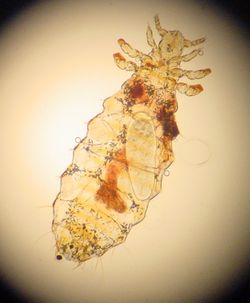| Sucking louse | |
|---|---|
 | |
| Linognathus setosus (Linognathidae) | |
| Scientific classification | |
| Kingdom: | Animalia |
| Phylum: | Arthropoda |
| Class: | Insecta |
| Order: | Psocodea |
| Suborder: | Troctomorpha |
| Infraorder: | Phthiraptera |
| Parvorder: | Anoplura Leach, 1815 |
| Families | |
| Synonyms | |
Siphunculata [1] | |
Sucking lice (known scientifically as Anoplura) are a parvorder [2] of around 550 species of lice. All sucking lice are blood-feeding ectoparasites of mammals. They can cause localized skin irritations and are vectors of several blood-borne diseases.
Contents
- Classification
- Characteristics
- Life cycle
- Feeding method
- Effects
- In humans
- In other animals
- Families
- See also
- References
- External links
At least three species or subspecies of Anoplura are parasites of humans; the human condition of being infested with sucking lice is called pediculosis. Pediculus humanus is divided into two subspecies, Pediculus humanus humanus, or the human body louse, sometimes nicknamed "the seam squirrel" for its habit of laying of eggs in the seams of clothing, and Pediculus humanus capitis, or the human head louse. Pthirus pubis (the human pubic louse) is the cause of the condition known as crabs.
